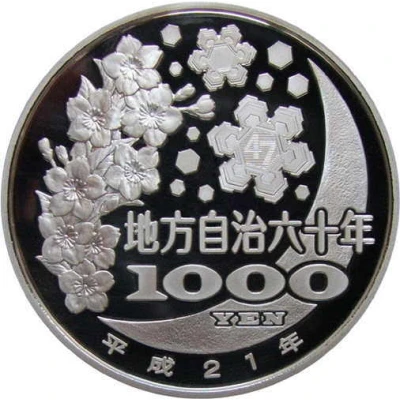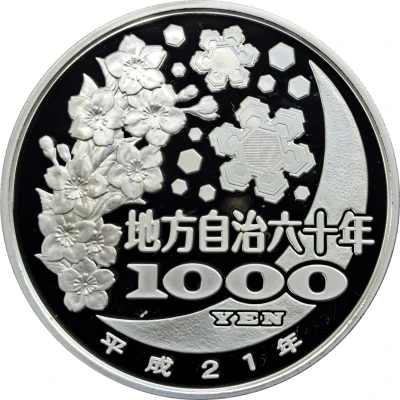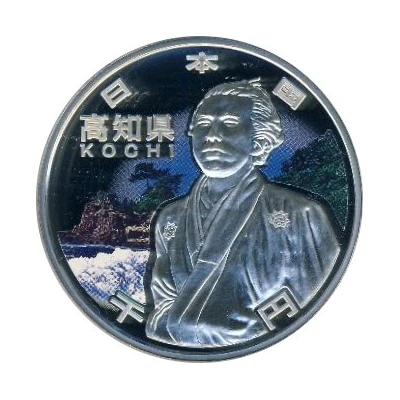


© In the World of Coins
1000 Yen - Heisei Nara
21 (2009) year| Silver (.999) | 31.1 g | 40.0 mm |
| Issuer | Japan |
|---|---|
| Emperor | Heisei (1989-2019) |
| Type | Non-circulating coin |
| Year | 21 (2009) |
| Calendar | Japanese - Heisei era |
| Value | 1000 Yen 1000 JPY = USD 6.72 |
| Currency | Yen (1871-date) |
| Composition | Silver (.999) |
| Weight | 31.1 g |
| Diameter | 40.0 mm |
| Thickness | 3.5 mm |
| Shape | Round |
| Technique | Milled, Coloured |
| Orientation | Medal alignment ↑↑ |
| Updated | 2024-10-06 |
| Numista | N#19552 |
|---|---|
| Rarity index | 83% |
Reverse
Cherry blossoms, crescent and snowflakes.
Latent images in largest snowflake.
Lettering:
(47/60)
地方自治六十年
1000
YEN
平成21年
Translation:
60 years of local autonomy
1000 Yen
Year 21 of Heisei
Edge
Slanted reeding right
Comment
2010 was the 1300th Anniversary of the Nara Heijo-kyo Capital. "Daigokuden Seiden" was the Former Imperial Audience Hall at Heijo Palace in the Heijo-kyo Capital, and is now being reconstructed. In those ancient days, the Emperor appeared in Daigokuden Seiden and national ceremonies were held there. Most of the Heijo Palace ruins have been preserved as a national historic site and a UNESCO World Cultural Heritage Site.A type of cherry blossom called "Nara-no-yaezakura" is the prefectural flower of Nara. Literally translated, "Nara-no-yaezakura" means a double cherry blossom tree in Nara.
"Kemari" is a ball game that is said to have come from China to Japan approximately 1,400 years ago and was played by aristocrats during ancient times in Japan. It has been passed down through the generations and is still played today. There are no winners or losers in this game, as the objective is simply to pass the ball to fellow players.
Interesting fact
The 1000 Yen - Heisei (Nara) 21 (2009) coin from Japan features a unique design that showcases the country's rich cultural heritage. The obverse side of the coin depicts a stunning image of a Japanese phoenix, also known as the "Ho-o," which is a mythical bird that symbolizes good fortune, prosperity, and longevity in Japanese culture. The phoenix is surrounded by intricate engravings of cherry blossoms and bamboo, which are also iconic symbols of Japan. The reverse side of the coin features the standard design used for all 1000 Yen coins, which includes the Imperial chrysanthemum crest and the inscription "1000 Yen" in Japanese characters. I hope you find this information interesting and helpful!
Price
| Date | Mintage | VG | F | VF | XF | AU | UNC |
|---|---|---|---|---|---|---|---|
| 21 (2009) | 100000 | - | - | - | - | - | - |
Values in the table are based on evaluations by sales realized on Internet platforms. They serve as an indication only for 1000 Yen - Heisei (Nara) 21 (2009) coin.



